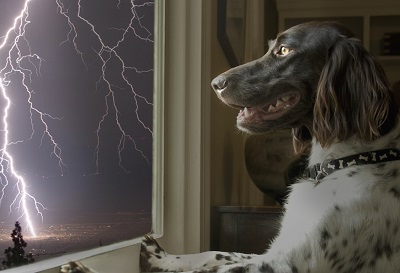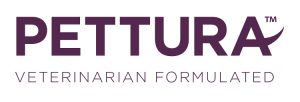In North America, we are in the midst of the hazy, hot, and often humid Summer months. With this weather comes festive fireworks celebrations and the potential for severe thunderstorms. This also means some of our canine companions will be scared by booming firecrackers and the tumultuous rumbling of thunder. In this week’s post, I share some information about storm and noise phobias, including effective ways to make our dogs feel more secure. Happy reading!
Storm & Noise Phobias – What are they?
Phobias are wildly exaggerated and irrational responses to a specific stimulus. The stimulus may or may not actually cause harm to the individual pet. In fact, often the stimulus is entirely innocuous. A drop in barometric pressure or wind wildly blowing leaves from branches can elicit a response from a dog with a storm phobia.
Storm phobias and noise phobias are not synonymous. In a study of 141 dogs, 90% of dogs with storm phobias had concurrent noise phobias, including fireworks and guns. However, only 75% of dogs with noise phobias had storm phobias.
Storm & Noise Phobias – How do dogs react?
Dogs with storm and noise phobias react differently, and multiple factors influence their responses. Common manifestations include:
- Pacing
- Destroying various items in a residence
- Drooling
- Trembling
- Inappropriate urinating and/or defecating
- Vocalizing
- Hiding
Storm & Noise Phobias – How are they treated?
Arguably the best way to treat storm and noise phobias is to avoid the inciting stimuli all together. Of course, that isn’t always possible or practical. So when avoidance of stimuli isn’t feasible, we have to turn to alternative interventions. Thankfully, there are many of them:
Training:
- Counter-Conditioning: Also called stimulus substitution, this treatment modality involves essentially changing an unwanted response into a wanted one by associating something positive with the fearful stimulus. For example, while exposing a phobic pet to a low level of a scary stimulus (i.e. noise), a pet parent plays ball and/or feed some treats. In this way, the positivity of playing or eating a tasty snack is paired with the phobia. The intensity of the negative stimulus can be managed to ensure it doesn’t induce a fearful response. The ultimate goal of counter-conditioning to ensure a positive association with the noxious stimulus.
- Desensitization Therapy: The technical definition of this intervention is a diminished response to a negative stimulus due to repeated exposure to it. Put simply, through repetitive sensory contact, the phobic pet essentially acclimates to the environment with the noxious stimulus. For example, a pet parent may use a recording of fireworks or thunder played initially at a low volume to expose a phobic dog to the scary sound. The volume can then be gradually increased as the animal acclimates. Desensitization therapy is usually used in conjunction with another intervention (i.e. counter-conditioning).
- Cue-Response-Reward Training: This form of intervention requires patience, repetition, and quite a bit of time. It also applies to more than just storm and noise phobias. One uses a specific set of cues to elicit a desired response from a pet when a scary stimulus is present. For dogs with noise and storm phobias, the desired emotional response is a calm state. Pet parents need to know it is important the initially conduct relaxation training in the absence of the triggering stimulus. Only once one can be certain a pet won’t manifest a fearful response should training in the presence of a fearful noise begin.
Medications: Many pets receive some form of pharmacologic intervention to help them cope with phobias. Specifically, dogs with noise and storm phobias often benefit from anti-anxiety medications. Pet parents should give anti-anxiety drugs before a stressful event. Therefore, pet parents need to be aware of things like weather forecasts and fireworks schedules. Some medications commonly used for noise and storm phobias are:
- Alprazolam (Xanax®)
- Dexmedetomidine oromucosal gel (SILEO®)
- Trazadone (Desyrel®)
- Diazepam (Valium®)
- Fluoxetine (Prozac®)
- Clomipramine (Clomicalm®)
- Clonidine (Catapres®)
- Amitriptyline (Elavil®)
Natural Supplements: The practice of medicine today often benefits from both traditional (i.e. Western) therapies and complimentary ones. For dogs with storm and noise phobias, the latter can often be helpful, especially when used in combination with some of the training modalities discussed earlier. Veterinarians and pet parents use a variety of supplements to help dogs cope with noise and storm phobias include:
- Dog-Appeasing Pheromone (Adpatil®) – Special glands in lactating female dogs normally secrete this hormone. This hormone has an appeasing effective on both adult dogs and puppies. Scientists developed synthetic DAP that is available as a spray, diffuser, and collar.
- Melatonin – Melatonin is a naturally occurring hormone from the pineal gland that anecdotally helps manage various phobias in dogs
- Harmonease® – This product contains extracts from Magnolia officinalis and Phellodendron amurense
- Zylkene® – This product contains cow-sourced hydrolyzed milk protein that has some calming properties
- Anxitane® – This product contains L-Theanine, an amino acid found in green tea leaves that may have some beneficial effects when used in conjunction with a behavioral modification program
- Royal Canin Veterinary Diet® Canine Calm dog food – This special diet contains tryptophan and a hydrolyzed mild protein to promote a relaxed state
Pettura™ Calming is an exciting new natural product that can be highly effective in dogs with noise and storm phobias.
It contains a novel combination of ingredients shown to have calming effects in our canine companions, including:
- L-tryptophan – this amino acid is a precursor to the chemical serotonin that has a calming and protective effect
- Chamomile extract – chamomile can yield some relaxing and sedative properties, ultimately easing anxiety and tension
- Ginger root extract – ginger can bind to serotonin receptors to reduce anxiety
- Valerian extract – valerian has known properties that promote physical relaxation
Veterinarians developed Pettura™ Calming. Dogs of all breeds, ages, and sizes can take Pettura™ Calming. This product comes as a tasty liquid, and is very easy to dose with a pre-measured pump. Most importantly, more than 80% of pet parents often observe calming effects in 15 minutes!
The take-away message about storm and noise phobias in dogs…
Noise and storm phobias are serious medical conditions in our canine companions. Fearful dogs can be dangerous and destructive. Thankfully there are several treatments available to help dogs cope with and overcome their phobias. These interventions may include specific training exercises, drugs, and even natural supplements. Pet parents are encouraged to partner with their family veterinarian, certified dog trainer, and board-certified veterinary behavior specialist to develop a therapeutic plan to maximally benefit their pets.
To find a board-certified veterinary behavior specialist, please visit the American College of Veterinary Behaviorists.
This blog post was made possible by Pettura™.
VETERINARIANS – For a FREE Pettura™ trial kit, including a Pettura™ Calming sample and coupons for your clients, click here. Vets only please!
PET PARENTS – For $10 off coupon for Pettura™ products, please use promo code CCDVM and click here.
Wishing you wet-nosed kisses,
cgb











